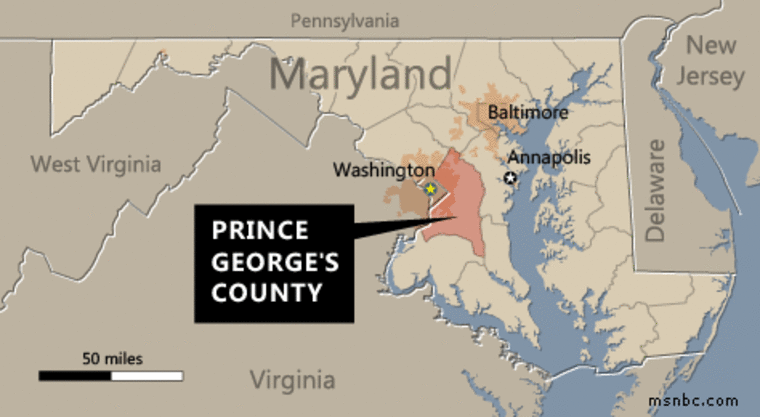This story has been corrected from an earlier version, which erroneously described a District Heights resident quoted in the article as black.
America’s wealthiest black county is in trouble.
Prince George’s County, Md., has gained prominence in recent years as the most affluent county in America with a majority African-American population. Average income in the county is almost double the national average for black families, according to the Census Bureau’s 2009 American Community Survey.
But the county, adjacent to the District of Columbia, has been laid low by the recession and the mortgage meltdown and now holds a more dubious distinction: a rising foreclosure rate that ranks as the worst in Maryland.
More than half of all housing sales in the county so far this year have been properties in foreclosure, a rate that dwarfs other counties in the state, according to MRIS, which provides listing services for real estate agents. This has caused a domino effect of social, economic and financial problems to ripple throughout Prince George’s communities.

Foreclosure sales, which have risen from 34 percent in 2009 to 51 percent so far this year, are just one sign of problems affecting Prince George's.
The county has imposed a hiring freeze, except for new public safety workers, and it recently cut $13 million from the school budget, although the county government's finances are solid enough that all three major rating agencies recently awarded it their top AAA bond rating. A wave of homicides this year has raised concern about safety in the county, and former County Executive Jack Johnson pleaded guilty last month to federal charges stemming from a sweeping corruption investigation.
Experts say there are a variety of reasons why the county ended up in the middle of the mortgage mess.
A decade ago, housing stock in Prince George’s was significantly less expensive on average than in any other suburban county in the D.C. metro area, so it had strong appeal for first-time homebuyers, said Anirban Basu, economic analyst and CEO of Sage Policy Group, a Maryland consulting firm. In general, home prices in low- and moderate-income neighborhoods rose more quickly in the boom and have fallen more sharply in the bust, Federal Reserve Gov. Janet Yellen noted in a speech Thursday.
Prince George's County also was a hotbed for speculative activity among professional and amateur investors during the housing upturn, Basu said. “The demographics of those affected correspond neatly to the demographics of a first-time home buyer: lower and less-stable incomes,” he said.
Bob Ross, president of the county branch of the National Association for the Advancement of Colored People, said it was clear that when the housing bubble burst, many newcomers were hit harder than the older, more established families.
“People didn’t fully understand what they were doing when they refinanced or when they took out more mortgages,” he said. “I can’t speak for the NAACP, but I do personally believe that discriminatory lending was going on.”
A 2008 report from the National Commission on Fair Housing and Equal Opportunity highlighted the practice of “reverse redlining,” which occurs when lenders target minorities with costly, subprime loans that they may not need or be able to afford. Analysis of data from 2006 indicates that roughly 54 percent of African-Americans and 47 percent of Latinos received subprime loans, compared with about 17 percent of whites, according to the report.
“If one considers the group that is most impacted (i.e. African-Americans and Hispanics), one can make a credible argument that the lending practices and the aggressiveness of subprime lender greatly contributed to the high rate of foreclosure,” Eric Brown, director of Prince George County’s Housing and Community Development Department said in an email.
Newly elected County Executive Rushern L. Baker III said his administration is doing everything in its power to help keep residents in their homes. County officials have allocated $1.8 million in their 2012 budget to rehabilitate abandoned and foreclosed properties.
Baker said in an email that the county is stressing preventative measures "to get people assistance before it’s too late.”.
Carol Gilbert, assistant secretary for neighborhood revitalization in Maryland’s Housing and Community Development Department, said Prince George's County accounts for 25 percent of the state's foreclosures. "It will get worse before it gets better, especially for Prince George’s County,” she said.
“While a lot of gains were made in home ownership, more so in the last three to five years, the foreclosure crisis really hit the minority community the hardest,” she said. “That’s a very big step backwards for building equity and wealth over time.”
In an effort to slow the foreclosure wave, the county is promoting non-profit housing counseling programs like the Housing Initiative Partnership (HIP), which provides financial literacy resources and helps homeowners understand their options.
With one in four people in Prince George’s behind on their mortgage, and only six counselors on HIP’s staff, their phones have been ringing off the hooks for the last three years and their calendars are booked for weeks, said Mary Hunter, director of the Housing Counseling Program.
“There’s just not enough funding to support the counseling that’s needed,” Hunter said.
Some may be hoping to find help in the state’s Emergency Mortgage Assistance Program. The Maryland Department of Housing and Community Development recently received federal funding to offer a limited number of no-interest loans to homeowners who have fallen behind because of loss of income due to unemployment or health issues.
“There’s a huge demand for this program now,” Hunter said. Eligible homeowners can get a zero-interest loan of up to $50,000 for two years to help them with their mortgage. “It can be the only hope people have to save their homes,” she said.